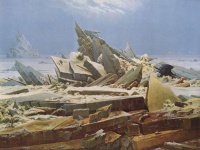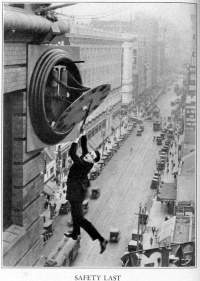Adventure fiction
From The Art and Popular Culture Encyclopedia

|
"In giving to the world the record of what, looked at as an adventure only, is I suppose one of the most wonderful and mysterious experiences ever undergone by mortal men, I feel it incumbent on me to explain what my exact connection with it is. And so I may as well say at once that I am not the narrator but only the editor of this extraordinary history, and then go on to tell how it found its way into my hands."--She: A History of Adventure (1887) by H. Rider Haggard "“He killed a man for her, do you say?” There was horror now in her voice."--Captain Blood (1922) by Rafael Sabatini |
_-_Hendrick_Goltzius.jpg)

|
Related e |
|
Featured: |
Adventure fiction is a genre of fiction that usually presents danger, or gives the reader a sense of excitement.
History
Don D'Ammassa argues that adventure stories make the element of danger the focus; hence he argues that
- "Charles Dickens's novel A Tale of Two Cities is an adventure novel because the protagonists are in constant danger of being imprisoned or killed, whereas Dickens's Great Expectations is not because "Pip's encounter with the convict is an adventure, but that scene is only a device to advance the main plot, which is not truly an adventure."
Adventure has been a common theme since the earliest days of written fiction. Indeed, the standard plot of Medieval romances was a series of adventures. Following a plot framework as old as Heliodorus, and so durable as to be still alive in Hollywood movies, a hero would undergo a first set of adventures before he met his lady. A separation would follow, with a second set of adventures leading to a final reunion.
Variations kept the genre alive. From the mid-19th century onwards, when mass literacy grew, adventure became a popular subgenre of fiction. Although not exploited to its fullest, adventure has seen many changes over the years – from being constrained to stories of knights in armor to stories of high-tech espionages.
Examples of that period include Sir Walter Scott, Alexandre Dumas, père, Jules Verne, Brontë Sisters, H. Rider Haggard, Victor Hugo, Emilio Salgari, Louis Henri Boussenard, Thomas Mayne Reid, Sax Rohmer, Edgar Wallace, and Robert Louis Stevenson.
Adventure novels and short stories were popular subjects for American pulp magazines, which dominated American popular fiction between the Progressive Era and the 1950s. Several pulp magazines such as Adventure, Argosy, Blue Book, Top-Notch, and Short Stories specialized in this genre. Notable pulp adventure writers included Edgar Rice Burroughs, Talbot Mundy, Theodore Roscoe, Johnston McCulley, Arthur O. Friel, Harold Lamb, Carl Jacobi, George F. Worts, Georges Surdez, H. Bedford-Jones, and J. Allan Dunn.
Adventure fiction often overlaps with other genres, notably war novels, crime novels, sea stories, Robinsonades, spy stories (as in the works of John Buchan, Eric Ambler and Ian Fleming), science fiction, fantasy, (Robert E. Howard and J. R. R. Tolkien both combined the secondary world story with the adventure novel) and Westerns. Not all books within these genres are adventures. Adventure fiction takes the setting and premise of these other genres, but the fast-paced plot of an adventure focuses on the actions of the hero within the setting. With a few notable exceptions (such as Baroness Orczy, Leigh Brackett and Marion Zimmer Bradley) adventure fiction as a genre has been largely dominated by male writers, though female writers are now becoming common.
See also
- Lost world (genre)
- Men's adventure, also known as the sweats, a genre of pulp magazine featuring tales of exotic adventure and wartime heroism.
- Nautical fiction
- Picaresque novel
- Robinsonade
- Subterranean fiction
- Spy fiction
- Swashbuckler
- Thriller (genre)
- True History by Lucian of Samosata
- Travel literature
- War novel


